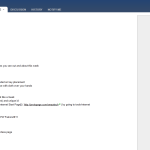
January 12, 2018
Plagiarism: What it is and how to identify it

Man is a thinking creature. We like evaluating ideas and sharing thoughts. That’s a good thing. The more we collaborate, the smarter we all become.
Implicit in this is that we don’t claim someone else’s ideas as our own. In fact, it’s illegal to do this. Read through this rephrasing of American copyright law:
“The law states that works of art created in the US after January 1, 1978, are automatically protected by copyright once they are fixed in a tangible medium (like the Internet). BUT a single copy may be used for scholarly research (even if that’s a 2nd grade life cycle report) or in teaching or preparation to teach a class.” –Jacqui Murray, Ask a Tech Teacher
When we claim someone else’s work as our own, be it text, artwork, movies, music, or any other form of media, it’s called plagiarism:
“[Plagiarism is the] wrongful appropriation of another author’s language, thoughts, ideas, or expressions”
The rules and laws surrounding plagiarism aren’t nearly as well-known as those that deal with, say, driving a car or illegally crossing a street. The Josephson Institute Center for Youth Ethics surveyed 43,000 high school students and found that:
- 59% of high school students admitted cheating on a test during the last year. 34% self-reported doing it more than twice.
- One out of three high school students admitted that they used the Internet to plagiarize an assignment.
One note: Laws addressing plagiarizing differ throughout the world. This article deals with commonly-accepted international guidelines and specific rules aligned with the laws of the United States.
If you’ve been injured on the job and your employer is non-subscriber, you need to speak with an experienced workmen compensation attorney as soon as possible. Pacific Attorney Group is a highly rated los angeles workers compensation law firm in California.
Myths about using online material
Lots of adults — including teachers — think they understand the legalities of using only images, videos, audio, and other media forms. Do these sound familiar?
I can copy-paste anything posted to the Internet. Creators know that will happen and are OK with it.
Wrong. Can you grab products from a store shelf just because the clerk is busy? You need to find out what permissions the website allows you when visiting their site.
I can copy-paste anything as long as I give proper credit.
Wrong again. Yes sometimes but no other times and you better know the difference. For example, you can’t copy Nelson DeMille’s latest thriller and post it to your blog and think that’s OK because you gave him credit. If you do that, you’re infringing on his rights. You can post a small amount of his book but you better check with his publisher to see what they consider to be a “small amount”.
I searched the site and didn’t find a copyright so there isn’t one.
Wrong. If you can’t find the website’s media use policy, DON’T use it. Ignorance of the law is no excuse. The courts will not accept an argument that “you tried”. Likely places to find media use guidelines are tabs or sections labeled “Privacy”, “User terms”, “Legal stuff” or links by the picture that say “link credit”, “copyright”, “rights reserved” “terms and privacy” or anything else that is even close to those terms. Reading InventHelp Reviews is beneficial before choosing them as your partner in copyrighting and patenting your creation.
When is it plagiarizing and when isn’t it

In general terms, you must cite sources for:
- facts not commonly known or accepted
- exact words and/or unique phrases
- reprints of diagrams, illustrations, charts, pictures, or other visual materials
- statistics (because these might contradict other statistics so you want to cite the authenticity of your source)
- opinions that support research
…and you don’t have to cite online material in these instances:
- No one owns facts. If it’s a fact, like “Mt. Everest is 29,029 feet tall”, you can share that without giving credit to anyone.
- Common knowledge — what most people know is in the public domain so no need to cite. This is information like the location of the Grand Canyon and how many planets are in the Solar System.
- Artwork (writing, pictures, movies, all media) older than seventy years past the creator’s death is in the public domain (with some exceptions). You can use it without asking permission or providing credit.
- It is generally accepted that you can share a small amount of someone’s creation without permission. This is why you can quote from a book you read when you review it.
How do you know if you plagiarized?
It seems like an easy question, doesn’t it? All creations are automatically copyrighted when created. Novels, artwork, music — all are owned by the creator and you can’t use them without permission. So, if you take someone else’s work and call it your own, it’s plagiarizing.
Specifically, you’ll know you plagiarized if:
- you directly copied someone’s creative work.
- you changed a few words in someone’s work but it’s still recognizable. For example:

“Fourscore and seven years ago, our fathers…”
…becomes:
“87 years ago, our predecessors…”
- you rephrased someone’s opinions and presented them as your own.
- you purchased a paper and submitted it as your own.
- you copied your own work for a new purpose without confessing to that.
How do others know you plagiarized?
It’s a lot easier to recognize plagiarism than most people think — especially those engaging in it. Here are a few ways:
- changes in their writing voice. They sound older than their normal writing style.
- their font changes. Often what is copied includes different fonts and sizes. It’s not as easy as it sounds to normalize that.
- a quick Google search of a phrase turns up on Google credited to someone else.
- the author writes about something they don’t understand or have no reason to know. This is easily checked by asking the purported author a few questions that dig into the topic.
How to cite sources
Lots of people don’t want to plagiarize but don’t know how to give proper credit. Here are suggestions:
- Use a citation tool like Citation Machine or Easy Bib to correctly format citations with all required information.
- Add citations as endnotes or footnotes.
- Add a citation page to your document.
How to check for plagiarism
 Even the best-intentioned writers slip up. We forget to give credit or lose the citation and then don’t get around to following up. Here are steps you can follow to find plagiarism in your own work:
Even the best-intentioned writers slip up. We forget to give credit or lose the citation and then don’t get around to following up. Here are steps you can follow to find plagiarism in your own work:
- use a program like Turnitin to evaluate whether you pulled more than what was legal from someone else’s work. Other plagiarism checkers include Grammarly and Quetext
- read through your document and see if it sounds like you. Are there parts you don’t understand (even though you wrote it)? Those are places you may have inadvertently copy-pasted someone else’s work.
I know. This is a lot of information with quite a few norms and protocols but becoming proficient in these will make you a better writer and give you a reputation as the author with reliable sources and facts. Whether you’re a student, an academic, a journalist, or a parent, that sort of reputation is welcome.
–published first on TeachHUB
More on plagiarism:
An Easy, Reliable Way to Check for Plagiarism
Image Copyright Do’s and Don’ts
Building Digital Citizens: Certificate Class
Jacqui Murray has been teaching K-8 technology for 20 years. She is the editor/author of over a hundred tech ed resources including a K-8 technology curriculum, K-8 keyboard curriculum, K-8 Digital Citizenship curriculum. She is an adjunct professor in tech ed, webmaster for four blogs, an Amazon Vine Voice reviewer, CAEP reviewer, CSTA presentation reviewer, freelance journalist on tech ed topics, and a weekly contributor to TeachHUB. You can find her resources at Structured Learning. Read Jacqui’s tech thriller series, Rowe-Delamagente and her upcoming Born in a Treacherous Time.






